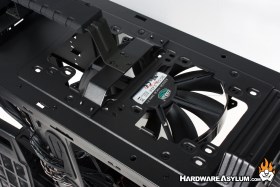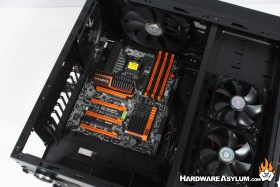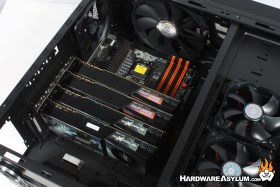Cooler Master Storm Trooper Gaming Case Review
Author: Dennis Garcia
Published: Tuesday, September 27, 2011
Case Interior and Installation
There are a few major features to highlight when it comes to the interior of the CM Storm Trooper. The first is the amount of cooling available. Out of the box the Trooper comes with four fans with the largest being a single 200mm top mounted fan that can be RPM controlled by the integrated controller or run independently using a motherboard fan header.
This top fan location is also universal and comes pre-drilled to accept two 120mm or 140mm cooling fans and radiator for those of you interested in DIY cooling solutions. As indicated by the default fan positions this is a negative pressure chassis with a multitude of intake locations.
This top fan location is also universal and comes pre-drilled to accept two 120mm or 140mm cooling fans and radiator for those of you interested in DIY cooling solutions. As indicated by the default fan positions this is a negative pressure chassis with a multitude of intake locations.
You will find two removable fan filters at the top and bottom of the chassis which will protect a top mounted radiator acting as an intake and bottom mounted PSU. The mesh venting along the side panels is unfiltered and will likely be responsible for dust inside your case.
Motherboard installation is rather straight forward and is currently designed to accept Micro ATX / ATX / XL-ATX motherboard form factors. We have installed the famed Gigabyte X58A-OC motherboard to give a sense of scale and to also demonstrate another major feature of this chassis.
The CM Trooper comes with a 9+1 expansion slot configuration meaning that it has nine expansion slot positions for the motherboard with an additional position for the patented StormGuard cable system or USB breakout panels.
Given the external nature of the +1 location we would suggest using the ninth expansion slot position for the StormGuard if you want your cables to remain exceptionally secure.
Motherboard installation is rather straight forward and is currently designed to accept Micro ATX / ATX / XL-ATX motherboard form factors. We have installed the famed Gigabyte X58A-OC motherboard to give a sense of scale and to also demonstrate another major feature of this chassis.
The CM Trooper comes with a 9+1 expansion slot configuration meaning that it has nine expansion slot positions for the motherboard with an additional position for the patented StormGuard cable system or USB breakout panels.
Given the external nature of the +1 location we would suggest using the ninth expansion slot position for the StormGuard if you want your cables to remain exceptionally secure.
To illustrate what it looks like to have nine expansion slot positions we have loaded the X58A-OC up with four dual slot video cards not only to show that they will fit but to give you a sense as to how much room is left when you're done.
Regardless of system configuration or cooling system you happen to install, short of a Single Stage Phase Change, there is clearly going to be enough room for your gear and enough volume left over to keep your system components cool.
Regardless of system configuration or cooling system you happen to install, short of a Single Stage Phase Change, there is clearly going to be enough room for your gear and enough volume left over to keep your system components cool.





